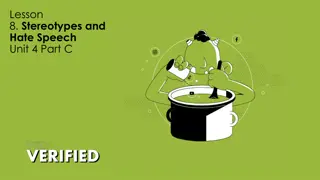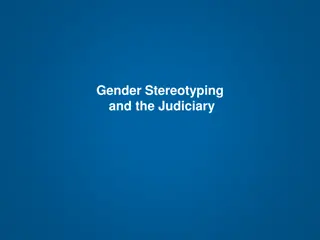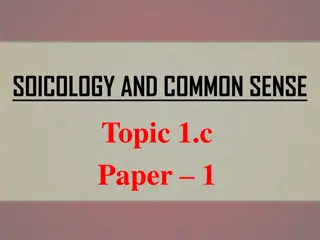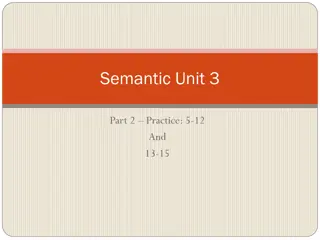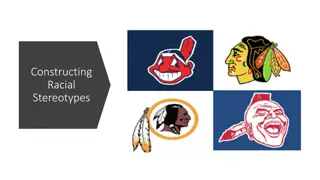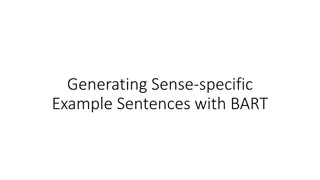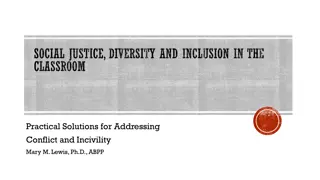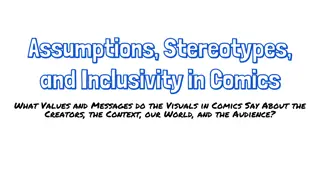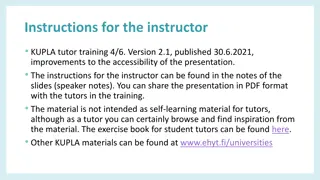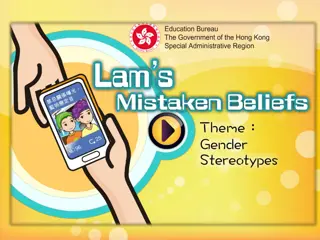Understanding Sense Properties and Stereotypes in Language
Effective communication hinges on shared meanings of words. Disagreements over word meanings can hinder understanding. Analyzing examples like distinguishing between "killed" and "dead" showcases how language's sense properties shape communication. Exploring analytic, synthetic, and contradictory sentences elucidates the core meanings inherent in language expressions.
Download Presentation

Please find below an Image/Link to download the presentation.
The content on the website is provided AS IS for your information and personal use only. It may not be sold, licensed, or shared on other websites without obtaining consent from the author. Download presentation by click this link. If you encounter any issues during the download, it is possible that the publisher has removed the file from their server.
E N D
Presentation Transcript
SENSE PROPERTIES AND STREOTYPES SENSE PROPERTIES AND STREOTYPES Created By: Dewi Rhonita Riri Created By: Dewi Susanti Rhonita Rizky Riri Rahmawati Susanti Rizky Rahmawati
In order to be able to talk meaningfully about anything, it is necessary to agree on the meanings of the words involved. This is a truism. In everyday life, people reach practical agreement on the meanings of almost all the words they use, and effective and successful communication takes place as a result. If a person wants to hinder or obstruct communication, he can begin to quibble over the meanings of everyday words. Although there may be disagreement about the fine details of the meanings of words around the edges , we find in the everyday use of language that all words are understood by speakers as having an indispensable hard core of meaning.
EXAMPLEI A: I saw something strange in the garden this morning. B: Oh! What was it? A: An animal perched on top of the clothes pole. B: How do you know it was an animal? A: I saw it. It was a cat. B: You might have seen a cat, but how can you be sure it was an animal? A: Well, of course it was an animal, if it was a cat. B: I don t see how that follows. So, the meaning of catincludes that of animal. 1.
EXAMPLEII A: I finally killed Ben s parrot. B: So it s dead, then? A: No, I didn t say that. Just that I killed it. B: But if you killed it, it must be dead. A: No. I was quite careful about it. I killed it very carefully so it s not dead. So, the meaning of killis related to that of deadin such a way that anything killed is necessarily dead. 3.
So, the kind of meaning we are talking about here is obviously the kind associated with words and sentences by the language system, and not the speaker meaning specifically associated with utterances made by speakers on particular occasions. This kind of meaning we call sense. The SENSE of an expression is its indispensable hard core of meaning. This definition deliberately excludes any influence of context or situation of utterance on the senses of expressions. The sense of an expression can be thought of as the sum of its sense properties and sense relations with other expressions. For the moment, we will concentrate on three important sense properties of sentences, the properties of being analytic, of being synthetic, and of being contradictory.
Definitions An ANALYTIC sentence is one that is necessarily TRUE, as a result of the senses of the words in it. An analytic sentence, therefore, reflects a tacit (unspoken) agreement by speakers of the language about the senses of the words in it. A SYNTHETIC sentence is one which is NOT analytic, but may be either true or false, depending on the way the world is. A CONTRADICTION is a sentence that is necessarily FALSE, as a result of the senses of the words in it. Thus a contradiction is in a way the opposite of an analytic sentence.
EXAMPLE Analytic: All elephants are animals The truth of the sentence follows from the senses of elephant and animal. Synthetic: John is from Ireland There is nothing in the senses of John or Ireland or from which makes this necessarily true or false. Contradiction: This animal is a vegetable is a contradiction. This must be false because of the senses of animal and vegetable. Both of John s parents are married to aunts of mine is a contradiction. This must be false because of the senses of both parents, married, and aunt.
PRACTICE I Label the following sentences either T for true, F for false, or D for don t know, as appropriate. Cats are animals T / F / D (T) Bachelors are unmarried T / F / D (T) Cats never live more than 20 years T / F / D (D) Bachelors cannot form lasting relationships T / F / D (D) Cats are not vegetables T / F / D (T) Bachelors are male T / F / D (T) No cat likes to bathe T / F / D (D) Bachelors are lonely T / F / D (D) Comment Sentences (a),(b),(e),(f) are analytic. Sentences (c),(d),(g),(h) are synthetic. 1. a. b. c. d. e. f. g. h.
PRACTICE II Here are some more sentences. Circle A for analytic, or S for synthetic, as appropriate. For some, you will have to imagine relevant situations. John s brother is nine years old A / S (S) John s nine-year-old brother is a boy A / S (A) Sam s wife is married A / S (A) Sam s wife is not German A / S (S) My watch is slow A / S (S) My watch is a device for telling the time A / S (A) So, Analytic sentences are always true (necessarily so, by virtue of the senses of the words in them), whereas synthetic sentences can be sometimes true, sometimes false, depending on the circumstances. We now come to contradiction. 1. 2. 3. 4. 5. 6.
Practice III Circle the following sentences A for analytic, S for synthetic or C for contradiction, as appropriate. For some you will have to imagine relevant situations. That girl is her own mother s mother A / S / C (C) The boy is his own father s son A / S / C (A) Alice is Ken s sister A / S / C (S) Some typewriters are dusty A / S / C (S) If it breaks, it breaks A / S / C (A) John killed Bill, who remained alive for many years after A / S / C (C) 1. 2. 3. 4. 5. 6.
The notions analytic, synthetic, and contradiction each apply to individual sentences. Analyticity, syntheticity, and contradiction are, then, sense properties of sentences. Example : That man is human has the sense property of analyticity (or of being analytic). That man is tall has the sense property of syntheticity (or of being synthetic). That man is a woman has the sense property of being a contradiction.
The STEREOTYPE of a predicate is a list of the TYPICAL characteristics or features of things to which the predicate may be applied. Example : The stereotype of cat would be something like: Quadruped, domesticated, either black, or white, or grey, or some combination of these colours, adult specimens about 50 cm long from nose to tip of tail, furry, with sharp retractable claws, etc., etc.
A stereotype is related to a prototype (see previous unit) but is not the same thing. A prototype of elephant is some actual elephant, whereas the stereotype of elephant is a list of characteristics which describes the prototype. The stereotype of a predicate may often specify a range of possibilities (e.g. the range of colours of typical cats), but an individual prototype of this predicate will necessarily take some particular place within this range (e.g. black). Another important difference between prototype and stereotype is that a speaker may well know a stereotype for some predicate, such as ghost, witchdoctor, flying saucer, but not actually be acquainted with any prototypes of it. Stereotypes of expressions for things learnt about at second hand, through descriptions rather than direct experience, are generally known in this way. The relationships between stereotype, prototype, sense, and extension are summarized very briefly in the chart. The notions of prototype and stereotype are relatively recent in semantics. We have in fact given definitions which sharpen up the difference between the two terms, which are sometimes used vaguely or even interchangeably. Important though the notion of stereotype is in everyday language, it is obviously not so basic to meaning as the idea of sense, which we have defined as an indispensable hard core of meaning. In this book we will deal no further with the notions of prototype and stereotype, but we will give a lot of attention to sense.
The sense of an expression can be thought of as the sum of its sense properties and sense relations. Sense properties of sentences include those of being analytic, synthetic, and a contradiction. With the exception of a few predicates such as bachelor, father, square, sphere, etc. it is not possible to give complete definitions of the sense of most predicates by sets of necessary and sufficient conditions. Stereotypes defined in terms of typical characteristics account for the fact that people usually agree on the meanings of the words they use.



